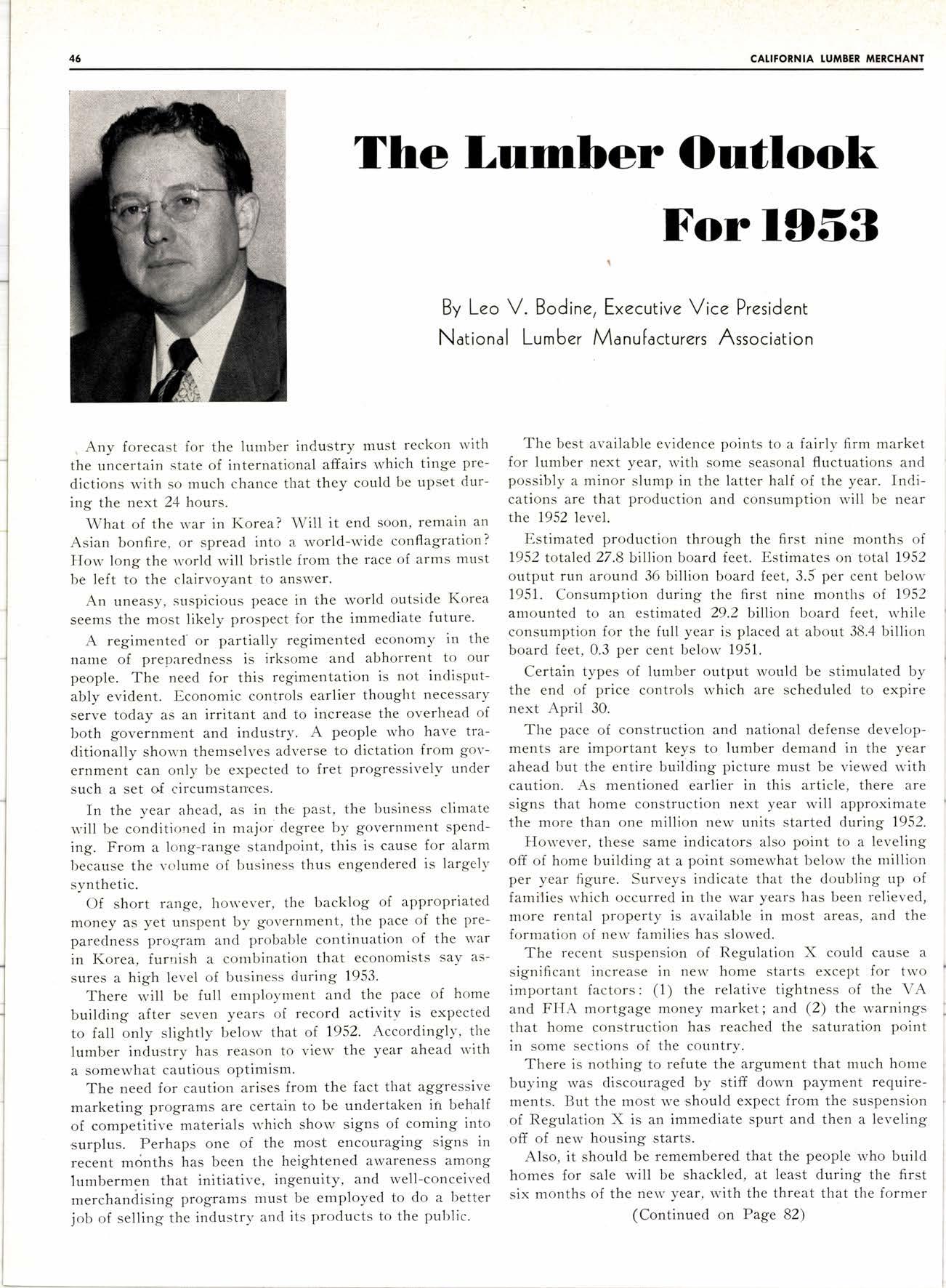
3 minute read
The Lumher Outlook For f953
By Leo V. Bodine, ExecutiveYice President National Lumber Manulocturers Associotion
, Aty forecast for the lumber industry must reckon rvith the uncertain state of international affairs which tinge predictions with so much chance that they could be upset during the next 24 hours.
What of the rvar in Korea ? Will it end soon, remain an Asian bonfire, or spread into a world-wide conflagration?
IIow long the 'n'orld will bristle from the race of arms mttst be left to the clairvoyant to answer.
An uneasy, sttspicious peace in the rvorld outside Korea seems the most likely prospect for the immediate future.
A regimented' or partially regimented economy in the name of preDaredness is irksorne and abhorrent to our people. The need for this regimentation isnot indisputably evident. Economic controls earlier thought necessary serve today as an irritant and to increase the overhead of both government and industry. A people who have traditionally shown themselves adverse to dictation from government can only be expected to fret progressivelv under such a set of circumstances.
In the year ahead, as in the past, the business climate u'ill be conditioned in major degree by government spending. From a long-range standpoint, this is cause for alarm because the vcrlume of business thus engendered is largelv synthetic.
Of short range, horvever, the backlog of appropriated money as yet unspent by government, the pace of the preparedness program and probable continuation of the u'ar in Korea, furrrish a combination that economists say assures a high level of business during 1953.
There will be full employment and the pace of home building after seven years of record activitv is expected to fall only slightly below that of 1952. Accordingly, the lumber industry has reason toview the year ahead I'ith a somewhat cautious optimism.
The need for caution arises from the fact that aggressive marketing programs are certain to be undertaken in behalf of competitive materials which show signs of coming into surplus. Perhaps one of the most encouraging signs in recent mdnths has been the heightened awareness among lumbermen that initiative, ingenuity, and well-conceived merchandising programs must be employed to do a better job of selling the industrv and its products to the public.
The best available evidence points to a fairly firm market for lumber next year, rvith some seasonal fluctuations and possibly a minor slump in the latter half of the year. InCications are that production and consumption will be near the 1952 level.
Estimated production through the first nine months of 1952 totaled 27.8billion board feet. Estimates on total 1952 output run around 36 billion board feet, 3.5 per cent below 1951. Consumption during the first nine months of 1952 an.rounted to an estimated 29.2 billion board feet, u'hile consumption for the {ull year is placed at about 38.4 billion board feet, 0.3 per cent below 1951.
Certain types of lumber output would be stimulated by the end of price controls which are scheduled to expire next April 30.
The pace of construction and national defense developments are important keys to lumber demand in the year ahead but the entire building picture must be viewed rvith caution. As mentioned earlier in this article, there are signs that home construction next year will approximate the more than one million new units started during 1952. Ifou'ever, these same indicators also point to a leveling off of home building at a point somewhat below the million per year figure. Surveys indicate that the doubling up of families u'hich occurred in the war years has been relieved, more rental property is available in most areas, and the formation of nerv families has slowed.
The recent suspension of Regulation X could cause a significant increase in new home starts except for two important factors: (1) the relative tightness of theVA and FIfA mortgage money market; and (2) the warnings that home construction has reached the saturation point in some sections of the country.
There is nothing to refute the argument that much home buying rvas discouraged by stiff down payment requirements. But the most we should expect from the suspension of Regulation X is an immediate spurt and then a leveling off of new housing starts.
Also, it should be remembered that the people who build homes for sale will be shackled, at least during the first six months of the new year, rvith the threat that the former
(Continued on Page 82)










